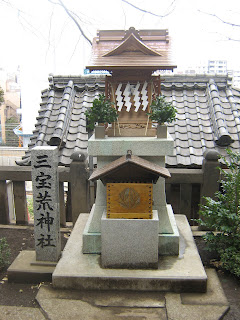Suwa-jinja 諏方神社 enshrines Take-Mi-nakata no Mikoto 建御名方命(たけみなかたのみこと).
Temizuya 手水舎
Front view of the main hall
The altar inside the main hall from up close
One out of a remarkable pair of archaic koma-inu 狛犬
A small hokora 祠 on the shrine grounds dedicated to Sanbō-Kōjin三宝荒神. In spite of his South-Asian appearance (he is often depicted with three faces and several arms), Sanbō-kōjin is the kami of the hearth of furnace (Ekubota, 2008: p14). In this respect, he may be slightly similar to the Di Penates of ancient Rome.
On the picture we see two branches of a sakaki 榊 tree, a divine mirror, a sacred rope (注連縄 shime’nawa) with shide 紙垂 and a wooden box for offering money.
Another hokora I have not been able to identify. The remarkable thing about this one is that is is made out of stone instead of wood.
Even more interesting for my research was an encounter with a very friendly elderly couple on the shrine grounds. This man and his wife walked up to me, initially aiming to practise his English as he had been taking some classes recently. The couple came to visit a nearby graveyard to pay their respects to a family member of the misses. The woman told me her parents, who passed away a while ago, were very devout Buddhists of the Nichiren school. The couple does not have a butsudan 仏壇 at home as neither of them were firstborn, but she does recall how the offerings were made at her parents’ home. Modest offerings of the day’s first rice, miso soup and tea/water were presented to the Buddha on the altar and taken away again around 3pm. These offerings were thrown away after usage, but offerings of fruit or candy were just put near the butsudan to be consumed later. Similarly, presents and souvenirs from visitors were presented to the Buddha/the ancestors before consumption.
The couple did not possess a butsudan at the time of our encounter, but they were considering buying one, even though they both stated they had their doubts about religion. The man of the house told me he had a Sōtō-shū 曹洞宗 background and to make sure I understood he was talking about a Zen-sect he closed his eyes and formed the Zenjō-jin 禅定印 (meditation mudrā) as he said the sects name. Since both had their own background I inquired how they would set up the butsudan as both traditions require different images or statuettes to be enshrined. 1 The man laughed and responded this problem had never occurred to him before I asked him. The woman, who seemingly felt guilty about their limited knowledge about the matter, tried to justify the situation by saying that her thoughts on religion changed because of religiously inspired terrorist attacks, like the one executed by AumShinri-kyō オウム真理教 members in 1995.
Footnotes:
1 Nichiren-shū has the Daimoku 題目 (Namumyōhōrengekyō 南無妙法蓮華経) in the middle with Daikoku-ten 大黒天 and Kishibo-jin 鬼子母神 to its flanks, whereas Sōtō-shū has Shaka-nyorai 釈迦如来 (the historical Buddha Śākyamuni [Skt: शाक्यमुनि]) in the middle, flanked by Jōsai-daishi 常済大師 and Shōyō-daishi 承陽大師 (Dōgen 道元).
Sources:
- Ekubota, Hiromichi (久保田裕道). 『日本の神さま』(Nihon no kami-sama). Tokyo: PHP Kenkyūsho (PHP研究所), 2008.
- Tōkyō-to jinja-chō (東京都神社庁). “諏方神社” (Suwa-jinja). Tokyo-jinjacho.or.jp/ (2012) < http://www.tokyo-jinjacho.or.jp/syoukai/23_arakawa/23002.html> (28-3-2012).








Geen opmerkingen:
Een reactie posten